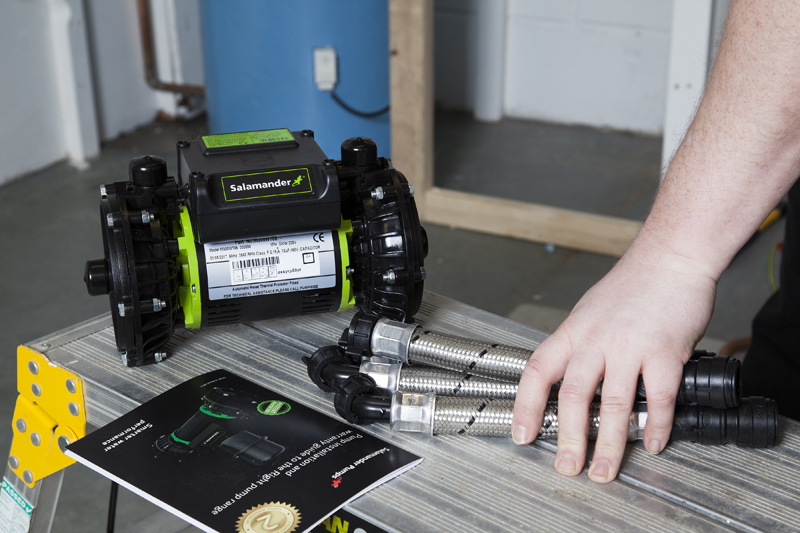
Fitting a shower pump is one of the most common ways to improve shower and whole house water performance. However, problems that occur during installation can reduce the product’s life and cause problems further down the line. To help educate the next generation of plumbers, Kenneth Vance, Training Manager at Salamander Pumps, took to New Durham College to demonstrate how to successfully install a shower pump. Here, he provides his step-by-step guide to a successful installation.
Installation
1.
Unbox the pump and read the supplied literature. It might sound obvious, but the installation guide should always be your first port of call, even for experienced plumbers. Each pump has a different design, meaning the installation for one pump could be slightly different from that of another. The installation guide provides you with a pre-installation checklist, product descriptions and technical specifications, step-by-step instructions as well as any helpful tips. These guides are also available online, where we also offer any further technical support that may be required.
2.
Fit the supplied feet to the pump, followed by the hoses. Make sure to be careful not to bend the hose too much, as Salamander’s hoses have an anti-vibration design, meaning that the hoses are not flexible and should not be bent more than 30 to 35° during installation, if at all. Bending or twisting the hose will cause problems with the water flow and will also invalidate the warranty, so it’s crucial that the hose is fitted as straight as is possible.
3.
Locate the pump in pre-determined location. Then isolate water supplies to the hot water cylinder and cold water tank and drain the system.
4.
If any soldering is to be carried out on pipework close to the pump or above it, the pipework should be set and clipped, then the pump and hoses removed so as not to come into contact with solder or flux. Any flux residue will erode the pump and can result in water leaks, so it’s important to make sure you don’t just attempt to protect the pump during the sweating process by covering it with some form of material, as this can be ineffective due to the spitting. The best way to ensure the flux avoids all contact with the pump is to ensure all solder joints are completed and flux residues removed prior to the pump connection.
5.
Create a connection to the cold water tank through the use of an appropriate sized tank connector and run a dedicated cold water feed to the pump. Remove the hot outlet connection from the cylinder if there currently isn’t a flange fitted and fit an appropriate flange, such as the Salamander S-Flange. Once the flange is connected to the cylinder, reconnect the vent pipe and any un-pumped services to the top connection of the flange (make sure to check which flange connections should be used first) and then take a dedicated feed from the side of the flange to the pump.
6.
Now that the supplies to the pump are installed, feeds from the outlets will need to be taken to the appliances being added to the pump, for example a shower. If this includes any up and over pipework, it is best to fit some air vents on the highest point of the system. Additionally, if the whole hose is to be supplied, there should be a dedicated vent pipe from the cylinder with the outlet of the pump supplying the whole hot water supply. This supply should not be linked back into the vent, as it would cause the pump to push water back into the vent and the cold water tank. If the pump and hoses had been removed before soldering, re-fit the pump. Make sure to fit filter washers to the inlets of the pump, and ensure the standard flat washers are on the outlets.
Commissioning
With the isolating valves turned off, re-fill the hot and cold water system and ensure all non-pumped outlets are functioning as they should. Turn on the inlet isolating valves and check for any possible leaks.
With all pumped outlets off, turn on the outlet isolating valves, again checking for any possible leaks. When water has been restored, before turning the electricity on to the pump, allow as much natural flow through pumped outlets as possible to ensure the pump and all pipework is flooded. If it’s not possible to obtain a natural flow (such as in a negative head situation) discharge water from the pump’s outlets into a bucket, using some pipe or hoses to ensure the pump is full.
Once all these steps are completed, the pump can be plugged into a socket or wired into a fused spur by a suitably qualified person. Switch on the electrical supply to the pump (negative head pumps will now operate briefly to charge up the outlet pipework), and then turn on all outlets one at a time to ensure the pump pressure is as desired.
Re-check the full installation for any possible leaks before tidying up. Provide the customer with all relevant literature and advise them on how to register the warranty.













